November 10, 2006
Air Date: November 10, 2006
FULL SHOW
SEGMENTS
The Election and the Environment
/ Jeff Young and Ingrid LobetView the page for this story
Host Steve Curwood turns to Living on Earth’s Washington Correspondent, Jeff Young, and Western Bureau Chief, Ingrid Lobet to see how the chips fell, environmentally, in the midterm elections. Living on Earth goes beyond the major election headlines to look closely at state ballot initiatives that could have significant political and environmental consequences in the coming years. (12:00)
The Energizer Voter
View the page for this story
Energy and the environment proved to be issues in election campaigns across the country. Living on Earth talks with Mike Bocian, Associate Vice President of the Greenberg Quinlan Rosner Research Firm, to get the post-game rundown on how the environment did in the polls. (05:00)
The Environment’s Future: Looking Ahead
View the page for this story
Political candidates talked the talk, now that they’ve been elected will they walk the walk? John Podesta, President of the Council for American Progress, and Representative Sherwood Boehlert of New York consider the new Congress with Living on Earth host Steve Curwood. (09:00)
Championing Change
View the page for this story
Will the changing political climate in Washington affect the congressional debate on climate change and global warming? Host Steve Curwood discusses the politics of climate change with Carl Pope, the Executive Director of the Sierra Club, and Steven Hayward, Resident Scholar at the American Enterprise Institute. (10:00)
Chasing Kangaroos
View the page for this story
Yes Virginia, there are, in fact, ten different kinds of tree kangaroos. Author Sy Montgomery traveled with scientist Lisa Dabek to the ancient cloud forest of Papua New Guinea in search of the Matschie’s Tree Kangaroo. They get up close and personal with this tree-hugging marsupial and document their trek in the new children’s book "Quest for the Tree Kangaroo. (08:30)
This week's EarthEar selection
listen /
download
A fledgling bald eagle goes fishing for dinner.
Show Credits and Funders
Show Transcript
HOST: Steve Curwood,
GUEST: Mike Bocian, Sherwood Boehlert, John Podesta, Steven Hayward, Carl Pope, Sy Montgomery, Lisa Dabek
REPORTERS: Ingrid Lobet, Jeff Young
[THEME]
CURWOOD: From Public Radio International - this is Living on Earth.
[THEME]
CURWOOD: I’m Steve Curwood.
As the impact of the Democratic takeover of Capitol Hill emerges, it’s clear that there is a new game in town for advocates of environmental protection.
YOUNG: This is no longer just about playing defense on environmental issues. (For years the environmental battles here in Congress had been about stopping things. Well) now, those who are interested in a more environmental agenda, instead of stopping things, they have a chance to start some things. They get a chance to play a little offense for a change.
CURWOOD: And voters seem to be connecting the dots between energy and environmental security faster than many politicians.
BOCIAN: If you look at those voters who voted for the Democratic candidate, but considered voting for the Republican, the number one concern they had about the Republicans was that they did nothing about the oil companies and the high gas prices.
CURWOOD: The environment, energy and the midterm elections and more this week on Living on Earth. Stick around!
[NPR NEWSCAST]
ANNOUNCER: Support for Living on Earth comes from the National Science Foundation and Stonyfield Farm.
[THEME MUSIC]
The Election and the Environment
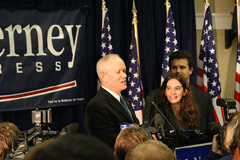
California Democrat Jerry McNerney beat Rep. Richard Pombo and celebrates his victory. (Photo: Nick Kocharhook)
CURWOOD: From the Jennifer and Ted Stanley Studios in Somerville, Massachusetts, this is Living on Earth I’m Steve Curwood.
The midterm elections not only shift the balance of power to the Democrats in Congress they also shifted the political terrain in a number of state houses. And these changes might make America a little greener. California democrat Nancy Pelosi is poised to become the next speaker of the US House of Representatives. Tops on her agenda: clean energy alternatives to oil imports.
PELOSI: When we talk about reducing our dependence on foreign oil, when we talk about that we talk about alternative energy. It’s not just about drill, drill, drill.
CURWOOD: In this program we’ll look into whether the Democrats can deliver on their energy agenda as we look at the election and the environment, who’s out, who’s in and what they’re likely to do.
CURWOOD: Living on Earth’s Washington correspondent Jeff Young is with us. Hi Jeff.
YOUNG: Hi Steve.
CURWOOD: And from Los Angeles our West Coast bureau chief Ingrid Lobet, hello.
LOBET: Hi Steve.
CURWOOD: Let’s start in Washington with you Jeff, this election really shook the ground there. How does it change the landscape for the issues of the environment and energy?
YOUNG: I’d say the best way to put it is that, this is no longer just about playing defense on environmental issues. For years environmental battles here in Congress had been about stopping things: stopping the oil exploration in the arctic refuge, stopping offshore drilling, stopping changes to major laws like the clean air act and the endangered species act. Now those who are interested in a more environmental agenda, instead of stopping things they have a chance to try to start something. They get a chance to play a little offense for a change.
CURWOOD: And they’ve got two fields to play on there’s the House it was the Senate. What should we watch for there on the environment in the Senate?
YOUNG: Well, I would say keep your eyes on the Senate environment committee, a very big change in power. The chair of that committee will go from Oklahoma Republican James Inhofe to California Democrat Barbara Boxer. And I challenge you to find any two lawmakers who are more diametrically opposed when it comes to their view on the environment. These two pretty much define the opposite poles of thinking. One example that springs to mind is climate change.
CURWOOD: Yeah, Jeff I remember Senator Inhofe’s statement. He’s really outspoken as a climate change skeptic. So let’s just dip into the archives for a moment for a little audio from one of those hearings.
INHOFE: Let me just once again state my belief that global warming is an alarmism and it’s a type of a hoax. The climate alarmism we hear in the media about impending planetary doom has taken on a striking resemblance to the classic story of chicken little.
CURWOOD: So Senator Inhofe thinks global warming is a hoax. What about Senator Boxer?
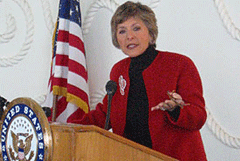
California Senator Barbara Boxer will fight to keep environmental issues on the agenda as chair of the Senate Environment Committee. (Courtesy of United States House of Representatives)
CURWOOD: And in the House who are the key players there to watch?
YOUNG: I would focus on the resources committee. I think that’s the most striking change on the House side. West Virginia Democrat Nick Rahall is going to be taking over from California Republican Richard Pombo. That’s a major shift in the paradigm there. Pombo had pretty much become the boogey man for environmentalists. It seemed like just about any bill that would have environmentalists up in arms would have Mr. Pombo’s name on it. He tried to weaken the endangered species act, he wanted to drill for oil in the Arctic. He wanted more offshore drilling. He even once proposed selling off parts of national parks. Now Pombo’s out, not only did he loose the chair, he lost his seat, and pretty much all those ideas, I think, go out the door with him.
CURWOOD: So Ingrid, what happened in that race? You covered the Pombo contest.
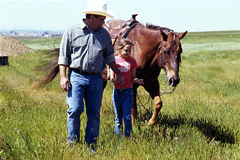
Congressman Richard Pombo with his daughter. (Courtesy of Richard Pombo for Congress)
But most of all I think it’s what Jeff has been talking about. It’s Pombo’s outspokenness on the need to take on the nation’s most important environmental laws. He really led the charge against the environmental agenda you could say. And that made him the target of what I think may have been an unprecedented campaign at least for the group Defenders of Wildlife, which led the charge.
They decided they wanted to get this guy out. They spent more than a million dollars. They organized buses of people to go door-to-door in his district even some of them who lived outside the district. They spent all this money on TV ads. And I think they can take some credit for what is a pretty big defeat: a chairman with 7 terms in Congress.
YOUNG: And I’d add that the environmental groups here in Washington are not shy about taking credit for that. They’re flexing their muscles and saying, “This is a message to anyone who thinks about tinkering with environmental protection. If you take on environmental protections, we’re going to take on you.”
CURWOOD: Now, Ingrid who’s new in Congress from the West? As I understand it there are several new members who have strong environmental records. Who comes to mind?
LOBET: Yeah, some of them will be quite a striking contrast. I think many listeners will have heard that Montana’s chosen for the Senate John Tester, an organic farmer who grows lentils and peas and alfalfa and also speaks very skeptically about free trade. People in Southern Arizona just chose a 36 year old, a woman, to represent them. Someone, Gabrielle Giffords, who the Sierra Club calls an environmental champion. She has a record in her state legislature on water and climate change issues. She wants to pay people to defray the cost of putting solar panels on homes. She wants to increase mile standards for cars. And she also lists a new national commitment to addressing global warming as a priority for her. And then there’s the man who defeated Pombo, Jerry McNerny, he’ll be the first alternative energy expert in Congress. He’s a wind energy engineer. So little by little these changes alter the discussion on clean energy in Congress I think.

California Democrat Jerry McNerney beat Rep. Richard Pombo and celebrates his victory.(Photo: Nick Kocharhook)
LOBET: Yeah, it wasn’t strange that Governor Schwartzennager was reelected. Here moderate Republicans have often done well in California. We had Governor Pete Wilson, we had Governor Duke Majin. And once Governor Schwarzenegger moved toward more moderate stances in the latter part of his term, in particular championing climate change measures and really continuing to make California a leader on that issue there really wasn’t any doubt that he was going to win reelection. And that sort of Republican has always been popular in California.
YOUNG: You know there are moderate, pro-environment Republicans who are now saying, “Hey that’s the lesson from this election. We’ve got to start pushing that kind of pro-environment, Republican moderate candidate if we’re going to recover from this disaster on election night.” And presumably if they follow that route that makes the environment common ground for possible bipartisan action.
CURWOOD: Now, there was a multimillion dollar campaign to tax oil to finance alternative energy went down to defeat there, prop 87. What happened?
LOBET: That was, financially, I think the biggest campaign in the country this year, the largest initiative in California history. One of California’s most prominent environmentalists, Steven Bing, sunk 50 million dollars of his own money into this measure to tax oil companies and fund alternative energy. And the oil companies buried Bing’s money in 100 million dollars in TV ads against the tax. I caught up with Scott MacDonald, spokesman for the no side at the GOP election bash in Beverly Hills and he blamed this huge waste of money, I guess you could say, on the initiative’s backers.
MACDONALD: These people could have spent 57 million dollars on something constructive and they didn't and so they need to answer for that. We need alternative energy. We are all about alternative energy. It is not a vote on that.
CURWOOD: Now, how did voters respond to other initiatives involving the environment?
LOBET: Also on the clean energy front, in Washington State, that became the latest place to require that a portion of the state’s electricity come from renewable power: 15 percent by 2020.
Voters in several states decided to limit the government’s power to take private property for things like urban renewal when that property is going to be given over to another private party like a builder. And these measures were very successful, they passed in 9 states. But where voters were asked to pass something more sweeping, let’s say for example, your local government downzones you. They decide they no longer want 5-acre ranchetts in your area and you were planning to rely financially on subdividing your property into 5-acre parcels when you get older. Several measures around the West would have allowed you to collect money from the government for that loss of value but those measures tended to go down. They went down in California, Washington, even in Idaho, Steve, a very conservative state traditionally. But in Arizona voters said yes to that.
And in other environment-related initiatives in perhaps a pre-emptive move against animal rights activists Georgia voters decided to enshrine hunting and fishing in their constitution. And, Steve, in Arizona voters decided to possibly try to fend off factory farms by banning so called gestation crates for sows.
CURWOOD: Let’s go back to Washington for a moment, Jeff and back to the Congress. There’s another thing Democrats have criticized Republicans about and that is that there’s just not been enough oversight of environmental programs and agencies that special interests have been able to get in there and write the rules and do things that maybe put money into people’s pocket rather than protecting the environment. What are the Democrats going to do about this now that they’re in control of both houses of Congress?
YOUNG: Yeah, that has been a persistent theme that this was a rubber stamp Congress. They didn’t really exercise oversight. I think you can expect more vigorous oversight from people like Senator Boxer in the Senate’s environment committee. In the house energy committee keep an eye on John Dingell, the veteran Congressman is returning to that position that chairmanship that he had 12 years ago. And back then he was very famous as a very tough investigator. Really digging into what the Department of Energy and Environmental Protection Agency were up to. And then there’s the House Government Reform Committee. California Democrat Henry Waxman is taking over there. I think we’re going to see more hearings and more investigations into things like climate change, were scientists censored when they tried to ring the alarm bells on climate change. I think they’ll want to know more about how the rules were written on mercury emissions from power plants. How did the Bush Administration come up with its energy policy and who was holding the pen when these rules were written.
CURWOOD: So speaking about climate change for a moment, any chances we’ll see action on climate change with Democrats in the majority?
YOUNG: I think that you can say safely that there are now more votes in both the House and the Senate for a cap on greenhouse emissions. However, it’s still a steep uphill climb to pass any meaningful legislation until there’s a change at the other end of Pennsylvania Avenue. Until the White House signals that they’re ready to entertain this idea I don’t see those bills moving.
CURWOOD: Jeff Young is our Washington correspondent and Ingrid Lobet is our West Coast bureau chief. Thank you both.
YOUNG: You’re welcome
LOBET: You’re welcome
Related links:
- League of Conservation Voters call Congressman John Dingell (D, MI-15), soon to be chair of the House Energy Committee, an environmental champion:
- Rep. Henry Waxman (D, CA-30) will soon led the House Government Reform Committee:
- Barbara Boxer (D-CA) will lead the Senate Environment Committee
[MUSIC: My Epiphany “Body Talk” from ‘Mirabilia’ (Eyeball Records – 2005)]
CURWOOD: Coming up: the environmental issue that made people switch from Republican to Democrat. Keep listening to Living on Earth.
The Energizer Voter
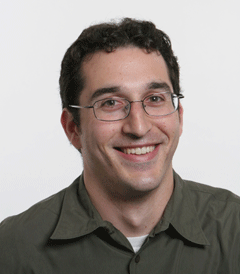
Mike Bocian is an Associate Vice president at Greenberg Quinlan Rosner Research Firm. (Courtesy of Greenberg Quinlan Rosner)
CURWOOD: It’s Living on Earth. I’m Steve Curwood.
During election season, people across the country heard many campaign ads with a common theme: energy.
ENERGY ADS: The price of gas is killing my farm. 86 bucks to fill up my pickup. I’m dumping my profit into the fuel tank. For farmers like me, the cost of gas is the difference between getting by and getting left behind. In Colorado the future is building wind farms in wheat fields but in Washington, Congress works for big oil.
CURWOOD: But in exit polls, energy didn’t show up in the top five most important issues on voters’ minds. So, how big a factor was energy and the environment in deciding midterm election winners? We decided to ask that question of Mike Bocian, the Associate Vice President of the Greenberg Quinlan Rosner Research Firm.

Mike Bocian is an associate vice president at Greenberg Quinlan Rosner Research. (Courtesy of Greenberg Quinlan Rosner Research)
That was one piece. The second piece was the positive side: the investment in alternative energy. And the voters believe that we are decades behind on investing in alternative energy and ending dependence on foreign oil and they haven’t seen the commitment they’re interested in on that issue.
CURWOOD: So, in a way your data is telling us that voters may well be ahead of politicians in linking environmental issues such as energy and alternative energy with core issues such as the war and the economy.
BOCIAN: Very much so. We’ve been seeing this for actually a few years now. Where we do focus groups where we talk to a dozen voters at a time across the country. And for several years now we have heard them talk about renewable energy and wonder why we’ve had the technology for decades why haven’t we set a course towards a renewable energy future. And the voters see this both as important to security and ending our dependence on foreign oil and our reliance on unstable countries, particularly those in the Middle East.
At the same time they naturally see renewable energy as a job creator. At a time when many of our manufacturing jobs have been outsourced they have a can-do spirit, a belief in America’s technological know-how that we can solve problems, that we can solve the renewable energy problem and create good jobs as a result.
CURWOOD: Mike Bocian, tell me of any particular races where you really saw these factors playing around energy and the environment.
BOCIAN: Sure, there were several and I’ll mention some. In the Governor’s race in the state of Iowa where Chet Culver was victorious, both candidates actually tried to use not just ethanol, the traditional energy issue in Iowa but wind power and other forms of renewable energy. And for Chet Culver his positive messaging it was a significant part, the notion of a brighter future for Iowa with good jobs, ending our country’s dependence on foreign oil. We saw it significantly there. We saw it play in a positive way by Governor Randell in Pennsylvania. At a critical time in what ended up being a landslide victory but that was a race that was very close early on. And Governor Randell made the case correctly that he had done significant steps to invest in renewable energy in the state and also to change many of the vehicles in the state’s fleet from regular gas cars to hybrid cars.
CURWOOD: From your polling I gather there’s a lot of concern about the fractiousness in the political process. How important is a spirit of bipartisan cooperation to those voters who are concerned about the environment and energy?
BOCIAN: It’s very important. They recognize that this problem will not be solved in a partisan way, that it will only be solved in a bipartisan way. And I think we saw in President Bush’s speech a few days ago that this is an issue he understands he can work across party lines on. Whether it will be mere rhetoric or actual policy that requires an investment and more reliance on alternative energy, remains to be seen, but it was one of the few issues he talked about in his speech as an area where he can work with Democrats. So I think the bipartisan component is very important.
CURWOOD: Your next set of numbers, what are you working on now, your next project?
BOCIAN: Well, I think a big part of the focus right now on these issues is how do we take elected officials who ran in significant degree on alternative energy and convince them to work across party lines to address this issue. I think that’s what the environmental community will be focused on. And from a research perspective we’re gonna try to investigate what exactly it is they’re looking for when it comes to alternative energy.
CURWOOD: Thank you so much, Mike.
BOCIAN: It’s been a pleasure.
CURWOOD: Mike Bocian is associate vice president of the Greenberg Quinlan Rosner Research firm.
Related link:
Greenberg Quinlan Rosner Research
The Environment’s Future: Looking Ahead
CURWOOD: For a look at the new landscape for the environment and energy in Washington we turn to two political insiders now. John Podesta, was Chief of Staff for President Bill Clinton and now heads the Center for American Progress. And Sherwood Boehlert is the twelve-term Republican Representative from New York and chair of the House Science committee.
John Podesta, welcome to Living on Earth.
PODESTA: How are you today?
CURWOOD: And Congressman Boehlert, hello.
BOEHLERT: It’s good to be with you.
CURWOOD: Representative, it seems like some of the Republicans who did well in this election had a strong environmental message, Arnold Schwarzenegger, Chris Shays survived in Connecticut. So is there a message to the Republican Party from those victories?
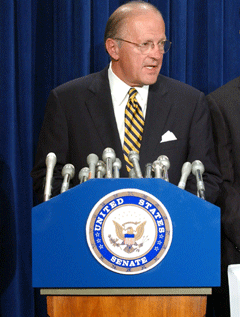
Congressman Boehlert at a press conference in the Senate Press Gallery. (Courtesy of United States House of Representatives)
CURWOOD: What’s going to happen with climate change? Are we going to see any caps? And what are the prospects of the White House policy changing? Mr. Podesta?
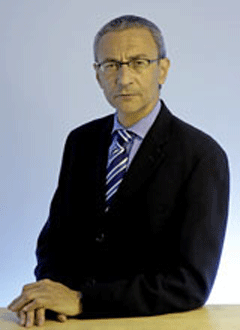
John Podesta is the President of the Center for American Progress and the former Chief of Staff for President Bill Clinton. (Courtesy of Center for American Progess)
BOEHLERT: Well, John I want to give you a cause for some additional cause for optimism and I’m an eternal optimist. And I point out to the detractors in my party that even the President of the United States concedes that global warming is for real. I’ve talked to him about this subject one on one. And I’ll tell your listeners just what I’ve told him. I’ll say, “Mr. President, every time I talk with you on a sensitive issue that might be divisive like global climate change, I always feel better after talking with you.” And then I pause for effect. “It’s your staff that screws it up.” And he usually laughs. But I really do feel that he gets it more than some of his staff people get it. And no president wants to leave after two terms in the White House without a sense that history will treat him well. And this is one area where I think the President has an opportunity to address, in a responsible way, something that is important to all Americans and I just have a gut feeling that he’s going to do it.
CURWOOD: So let’s talk now about a big Democrat in the House is John Dingell. He’s been on the hill, it’s been almost 50 years or something like that.
PODESTA: Yeah, back in the 1950s.
CURWOOD: He’s in line to get back his committee chairmanship as House energy. Now in the past he’s opposed fuel efficiency. He’s opposed greenhouse gas caps. How much of a stumbling block do you think he’ll be for Democrats for the Congress in terms of focusing on environmental change and climate change in particular?
PODESTA: John Dingell’s been a champion on certain environmental issues: protection of natural resources. You know he’s a great hunter. He loves the land and protects natural resources. He’s been strong on clean water act. But he also comes from a district that is an auto-producing district and has been always worried I think about the impact of particularly clean air questions on the auto industry. I think that he understands now that probably one of the most important questions facing not only this country but facing the world is global warming and climate change and I think you’ll see him be active on the energy question and on the climate change question, I certainly hope so. Y’know, I think he’ll be pushed also by the members of his committee, who I think have gotten both educated on the question and will push forward to try to make some real change on that question.
CURWOOD: So let me ask you Congressman Boehlert, you’ve worked for many years on Capitol Hill with John Dingell across the aisle, sometimes in the majority, sometimes in the minority. How do you think he’s going to be to work with now on the question of climate change, global warming given that he does come from where they make cars in Michigan?
BOEHLERT: Well, that’s a big question mark. I have the highest regard for John Dingell. In so many areas I find myself a kindred spirit with him. But I would point out to one and all that he was the 800-pound gorilla in the room that has blocked repeatedly, been the leader of the opposition to the joint bipartisan effort on CAFÉ standards. The science is on our side. The technology exists to make more fuel efficient vehicles today. But quite honestly our primary opposition from that common sense approach has come from John Dingell, the auto industry, and I understand no one likes mandates, they don’t want to be told by the government they have to do anything, but if we sit back and wait for a voluntary program to trigger in we’ll probably wait throughout eternity.
PODESTA: I think I’d add just one point to what the Congressman said which is we absolutely need to improve the efficiency of our vehicles and we also need alternative fuels. And I think there’s a lot of bipartisan support in the Congress to try to move towards backing out some of the oils that we do import by really using the science to bring forward cellulosic ethanol and new fuels that will, in combination with more efficient vehicles could take a huge dent out of both the imported oil and the security concerns that go with it and also really reduce our greenhouse gases.
CURWOOD: Some would say that’s what happening in Washington on the question is kind of agreeing to collude to the oil addiction. I mean the president said we’re addicted to oil. But so far responding to the problem of addiction to oil from really both sides of the aisle kind of looks like two alcoholics saying, “Gee this is really bad for my liver” while ordering another scotch.
PODESTA: Well, maybe I’ll take that one first. I think the Congressman has rightfully said that both parties or at least some leaders in both parties have been impediments to raising CAFÉ standards. When I was in the White House working for President Clinton when we were trying to do that there were constantly riders put into appropriations bills that blocked our ability to do it. And that was bipartisan in its support. But I think things have changed. And I think that you see more leadership-I like to think that it’s from my party- but I think that we really need it from both parties to really move forward on this and to kind of break down the special interests hammerlock that particularly the oil companies have you know on the Congress in the past and on this administration.
BOEHLERT: I’m very optimistic as I look forward, not because of the election results, I’m a little be disappointed that the Democrats are back in the majority and my fellow Republicans are back in the minority. But the principle message out of the election of 2006 was that the American people are sort of fed up with the polarization and the lack of consideration for another point of view. And what they’re saying to those of us in Washington is sort of come together, agree on the problems and then try to develop a consensus solution. Don’t just talk about it. Do something.
CURWOOD: I want to thank you both. Sherwood Boehlert is the outgoing Republican Representative from New York’s 24 district where he served 12 terms without ever being defeated because you chose retirement, Sir. Thank you so much.
BOEHLERT: Thank you.
CURWOOD: And John Podesta is president of the Center for American Progress and formerly chief of staff for President Bill Clinton. Thank you, Sir.
PODESTA: Great to be with you. And Congressman, thank you for your service.
BOEHLERT: Thank you so much.
Related links:
- Congressman Sherwood Boehlert
- The Center for American Progress
Championing Change
CURWOOD: Washington is home to an army of lobbyists who champion everything from environmental protection to free markets - two approaches, by the way that are often at odds. But the trends linked to this year’s elections seemed to have shaken some of those predictable line-ups, as well as the legislative majorities. Joining us to discuss climate change and the changing political climate is Steven Hayward, Resident Scholar at the American Enterprise Institute, a free market-oriented think tank. He writes AEI's Environmental Policy Outlook.
Welcome to Living on Earth, Mr. Hayward
HAYWARD: Good to be here.
CURWOOD: And from San Francisco, Carl Pope he is the executive director of the Sierra Club. It’s the nation’s oldest and largest grass roots environmental organization. Welcome Mr. Pope.
POPE: It’s great to be back.
CURWOOD: Carl Pope let me ask you specifically with a Democratic majority in the House with a razor thin majority in the Senate, what happens in terms of climate change at the federal level from your perspective? And what would you like to see happen?
POPE: Well let me distinguish between what happens on climate change and what happens on the things that help solve climate change. I think we’re likely to see some substantial forward progress at least in the House perhaps in both houses on renewable energy and efficiency. I think that is part of the agenda that is not as controversial. And that I was going around the country this year you saw all over the country you saw political ads featuring wind turbines. So I think we’ll see some substantial forward progress at least in Congress and I hope the President will go along on renewable energy. I think on the question of an ultimate national climate change policy, the House may pass a strong piece of legislation. The senate I think with the 60-vote rule is unlikely to do so. I think the remaining global warming deniers in the Senate will be willing to filibuster anything meaningful that establishes an umbrella national policy on global warming. So my guess is we don’t actually see that happen. But you might well see a bill pass the House. Henry Waxman has a good bill in and of course there’s now the California bill signed by a Republican governor that will serve as a bipartisan model, which is somewhat different than Waxman’s bill. So I think you’ll see some real action in the House. But what I really want to see is some action in both houses on the solutions to global warming, especially the relatively non-controversial issues like efficiency and renewables.
CURWOOD: Steven Hayward this administration really has played down the need to respond to the threat of global warming. So how much do you think the administration might move its position in light of these election results?
HAYWARD: Well, there was an interesting straw in the wind 2 or 3 months ago reported by Mike Allen in Time Magazine. It raised a lot of eyebrows and generated a lot of buzz in Washington. Mike Allen reported that he was talking to a senior White House official who said that Bush was getting ready to do a 180 on climate change and describe it as in the old cliché as a Nixon in China moment. The actual quote that appeared was that only two oil men could get all the players to the table, including the oil and auto industry, to broker some large and grand compromise on this.
And I’ve heard separately from people who have had casual lunches or dinners with Bush recently that one of the things he’s changed his mind about was environmental issues. And I’ve asked for details and mostly people say we were there to talk about Iraq so we didn’t ask for details. Now this has been controverted by a number of named people in the White House saying , “no this is an exaggeration, it bears the hallmarks of possibly a trial balloon by a faction perhaps in the White House trying to push things this way.” But there’s still some thought that you may be seeing some large initiative proposed in the state if the union address next year. And if that’s the case then it might be a whole new ball game.
CURWOOD: We’ll continue our conversation with Steven Hayward and Carl Pope in a just a few moments. Keep listening to Living on Earth on PRI, Public Radio International.
[MUSIC: Crystal Skulls “No Room For Change” from ‘Blocked Numbers’ (Suicide Squeeze Records – 2005)]
CURWOOD: If you enjoy listening to Living on Earth, chances are you have some pretty good ideas about things the program should cover. Good news, bad news or just plain interesting--if you think it would make a worthwhile story for the radio, please get in touch. You can zap us an email at comments @ l-o-e dot org. Or call the Living on Earth listener line, at 800-218-9988. That’s 800-218-99-88. Or write 20 Holland Street, Somerville, Massachusetts 02144.
You’re listening to Living on Earth on PRI - Public Radio International.
CURWOOD: It’s Living on Earth. I’m Steve Curwood. Back now to our post-election conversation with Carl Pope from the Sierra Club and Steve Hayward, from the American Enterprise Institute. So let’s turn now to the nuclear industry. Some environmentalists have joined industry saying we should give nuclear power another look because of climate change and greenhouse gases. Carl Pope, what kind of traction do you think that’s going to get in this Congress and what kind of traction do you think it should get?
POPE: Well, if somebody wants to build a nuclear power plant with their own money, God bless them. Nobody does. Everybody wants to build nuclear power plants with somebody else’s money; usually the American taxpayers. I mean the subsidies contained in the last congressional energy bill were so bad that the Wall Street Journal denounced them and the Bush Administration declined to support them. So I think that the difficulty with nuclear power is you can make it safe then it’s not cheap. You can make it cheap but then it’s not safe. And so far, so far, but I’m an agnostic on the future, nobody’s figured out a way to do both. But at the same time we shouldn’t throw all of our investment dollars in things which don’t show much sign of penciling out economically. When we have a ton of stuff in the efficiency and renewable areas that is extremely promising economically and in many cases would be happening in the free market if government wasn’t getting in the way. And Steve probably even agrees with that.
CURWOOD: Well Steve Hayward, let me ask you in your organization the American Enterprise Institute looks to market based solutions whereever possible. What about the argument that maybe nuclear would be ok as long as the private markets do it?
HAYWARD: Yeah, Carl’s right. I am in substantial agreement with him. In fact I passed around the op-ed article he wrote with Ed Crane in the Washington Post a couple years ago saying let’s have a level playing field for all energy technologies and get rid of all the subsidies.
POPE: That deal is still on the table.
HAYWARD: Well see, by the way, I mean I tell my environmental and liberal friends this shows in some respects our essential powerlessness of our two different camps. That we can’t seem to push that very far down the field because we could get together on that one. I do think if we go to, as I think ought to be thought about, a carbon tax down the road, as a way of leveling the energy playing field and adjusting our energy portfolio in this country, then the economics of nuclear power and other alternative energies begins to change quite a bit. I mean Carl’s right about nuclear subsidies. I was against them, still am against them. But some alternative energies, like wind power also have some large subsidies and tax breaks. So yeah, I think I could reach a large agreement with Carl that we ought to get rid of all these things and try and level the playing field and stop a lot of the special interest gaming of this business.
CURWOOD: And what I hear from you is a new tax, a carbon tax.
HAYWARD: Yeah, I don’t think either party is going to go there. Democrats will be afraid of being the tax accusation from Republicans and they’re always right to be. And I don’t think Republicans are going to lead with that either. But a lot of economists will tell you that would be the best way forward on this issue and so I think a few years down the road that may unfold.
CURWOOD: So let me ask you about this….
POPE: Can I…can I just really reach across the ether to shake his hand. I completely agree.
CURWOOD: If we’re not careful here you guys are going to get together and start singing Kumbaya or something. How can this prevail in the halls of Congress? What are your plans to in fact have the Congress come together where there is consensus, say around renewable energy and such, the need to address these issues and have something that comes out as a product of consensus rather than you know, the bloodied remains?
POPE: Hey, I’m the executive director of the Sierra Club, not Plato’s philosopher king. I don’t think I know how to do that. More seriously though, what’s interesting is what’s happening at the state level. You are seeing it at the states. I mean it is a remarkable thing that it is easier for the Sierra Club, which frankly is not very popular in Idaho, but it is easier for us to walk in to the Idaho legislature and sit down with the Republican caucus in the Idaho legislature and talk common sense about energy than frankly it is to talk with either party in Washington DC. There is something profoundly broken at the federal level that is not profoundly broken at the local and state level. And I’m not sure I have the precise answer about why, but I think the solutions to what ails Washington lie in trying to understand what is the dynamic that enables states as disparate as California and Georgia to work out these issues in a relatively non-partisan way with very different local politics. And yet the same thing cannot seem to happen in Washington.
HAYWARD: Well we don’t seem to have a national climate policy we can point to with bullet points saying we’re doing X,Y and Z. But there’s a lot going on. Carl pointed to some things on the state and local level, which I think part of that is show, but part of that is real. And then you have a lot of industries taking the lead trying to become more energy efficient for their own purposes. So, I’m actually more optimistic than a lot of the gloomier projections that the curves are going to start bending in a more favorable direction a lot faster than people think.
CURWOOD: Steven Hayward is resident scholar of the American Enterprise Institute. Carl Pope is the executive director of the Sierra Club. Thank you both gentlemen.
HAYWARD: Thanks for having us.
POPE: Thank you.
Related links:
- The American Enterprise Institute for Public Policy Research
- The Sierra Club
[MUSIC: Shapes and Sizes “Island’s Gone Bad” from ‘Shapes and Sizes’ (Asthmatic Kitty Records – 2006)]
Chasing Kangaroos

A tree kangaroo at home in the Cloud Forest in Papua, New Guinea. (Photo: © Nic Bishop)
CURWOOD: If you were to look up in a tree and see a kangaroo, you might jump out of your skin in surprise. What’s a kangaroo doing in a tree? Well, if it’s a tree kangaroo, it’s probably making itself right at home. Not much is known about the elusive tree kangaroo, but scientist Lisa Dabek hopes to change that.
She’s been researching these teddy bear-like tree climbers and working to conserve the ancient forests of Papua New Guinea that one species of these high altitude marsupials calls “home.” On her last field expedition, Lisa Dabek brought along author Sy Montgomery. Sy wrote a children’s book about their adventure called “Quest for the Tree Kangaroo.”
Sy and Lisa, welcome to Living on Earth.
MONTGOMERY: Thanks for having us.
DABEK: Thank you, it’s great to be here.
CURWOOD: So, Sy, what’s a tree kangaroo look like?
MONTGOMERY: Oh my gosh. It looks like something that Dr. Seuss would have made up if he was working with a manufacturer of stuffed toys.
CURWOOD: (laughs)

A tree kangaroo at home in the Cloud Forest in Papua, New Guinea. (Photo: © Nic Bishop)
CURWOOD: Sy, when you first went into the cloud forest where these tree kangaroos are at home, what was it like? What did you see? What is one of these cloud forests like?
MONTGOMERY: Oh, man. It’s a gorgeous gorgeous place. I like to tell people it’s like what heaven would look like if heaven had leaches.
CURWOOD: (laughing) Ok.
MONTGOMERY: And who knows, maybe they do. First of all to get there this is the most remote place I’ve ever been in my life of all the expeditions I’ve ever done. We had to hike for three days up into the cloud forest, up to 10,000 feet, where the forest is just shrouded in mist. It feels like a mystical magical place. And all the great trees are covered in moss. And the moss is laced with ferns and there’s great big vines hanging from everything, thick with moss. There’s orchids growing out of the trees. There’s rhododendrons growing out of the trees. Some of the flowers are huge and showy and some of them are small as a dress maker’s pin. And it looks just like the kind of place where you’d expect some hobbit or a troll to step out. But better than that, look who’s there: kangaroos in the trees.
CURWOOD: Now Lisa, these guys are hard to see, let alone monitor or track. What do we know about tree kangaroos? And what have you learned in studying them?

Lisa Dabek on her way to the Cloud Forest. (Photo: © Nic Bishop)
CURWOOD: Lisa how do you catch an animal that’s hard to see? And looking at the book that you guys put together, the photographs, seems to be perfectly happy at 85 feet up in the air.
DABEK: I know, it’s amazing. The villagers, the hunters, spot them. And then they cut down the brush underneath the tree. And they surround the tree. And then one of the men climbs a neighboring tree and starts making noise to frighten the animal. And the animal, when it wants to get away, it can leap down as far as 80 feet. And once the animal lands on the ground the hunters can grab the tail of the animal.
CURWOOD: Ouch
DABEK: I would not be able to do that.
CURWOOD: Now, you get the locals to help you catch them. And then what do you do once you’ve got a tree kangaroo?
DABEK: Well, we have a team of researchers and we take blood samples and measurements of the animals. And then we put radio collars on them to really get a good handle on the home range of the animals because that’s going to determine how much forest we really need to protect for healthy populations of animals. And then we’re also trying to get a good handle on their feeding ecology. So far we’ve documented that they eat over 90 species of plants. So we put the radio collars on but we’re also, these blood samples and fecal samples we’re able to look at the genetics of tree kangaroos. And that’s really important because very little is known about the taxonomy and classification of tree kangaroos. There was a new tree kangaroo species that was discovered in 1995, only ten years ago. And for a large mammal that’s pretty exciting.
CURWOOD: Now, Sy, from your visit there how do the people in New Guinea view the tree kangaroos?

Tree Kangaroos have been known to jump down 85 feet from their lofty perches in the cloud forest. (Photo: © Nic Bishop)
CURWOOD: Animals like this often have some folklore about them. What’s something special that folks there believe maybe a myth about the tree kangaroo?
MONTGOMERY: Well, they obviously think that tree kangaroos have some special power, because there’s one belief that if you think of the girl that you love before you let your arrow fly to shoot a tree kangaroo, at the moment the arrow pierces the animal’s body that’s when she will fall madly in love with you.
CURWOOD: Oh, my. That makes it tough on the tree kangaroos.
MONTGOMERY: Yeah, I know. It’s really a pretty rotten Valentine’s Day gift for them.
[LAUGHS]
CURWOOD: Lisa, what are the major challenges facing the tree kangaroo in terms of conservation?
DABEK: In this area it’s mainly over hunting. And that’s why we can work with the local hunters to talk about sustainable resources. Because with them agreeing to set aside portions of land that are safe for the animals to breed and then disperse they actually can have a sustainable resource. In other areas of New Guinea it’s logging and mining, so basically the destruction of the tree kangaroo’s habitat.
CURWOOD: What do you hope this book accomplishes, Sy?
MONTGOMERY: Well, a couple of things. First it’s a great adventure story about real science. This is like a National Geographic expedition. You know 44 people from three continents including quite a few local people hiking for three days to a totally unknown place to study an animal about which almost nothing is known. That’s just a great adventure story that makes science exciting to kids. And Lisa’s a great heroin. I mean she’s a fabulous scientist and a thing that few people know, but will after they read this book about her is that even though she’s working at ten thousand feet in this very strenuous environment, she has asthma and she has not let that stop her. She also didn’t let it stop her when other scientists said that what she wanted to do would never work. So that’s a great lesson for kids.
Another thing, because she’s amassed this large team of people from all over the world, some of us bring to this job talents you wouldn’t think could help conservation. So whatever talent you have you can bring this to help the world remain whole. But the one thing of course that I really want to get across the most, and you know this Steve, is that all of my books are really love stories. And these animals, you just look at them and immediately you just loose your heart. You love them. You can not help but want to know that they are going to be surviving half way around the world, even if you never even visit a zoo, you want to know that they are continuing to survive in this fairy tail, beautiful habitat of the cloud forest of Papua New Guinea.
CURWOOD: Thank you both for being with me.
MONTGOMERY: Thanks Steve, it was great.
DABEK: Thank you so much.
CURWOOD: Lisa Dabek is a scientist who’s worked with tree kangaroos in Papua New Guinea, and Sy Montgomery is the author of the book “Quest for the Tree Kangaroo.” To see photos of the tree kangaroo by Nic Bishop, go to our website, www.loe.org.
Related link:
"Quest for the Tree Kangaroo: An Expedition to the Cloud Forest of New Guinea" by Sy Montgomery
[MUSIC: Man Man “10 Lb. Moustache” from ‘Solid PR Presents, Vol. 1: A Benefit for the National MS Society’ (On the Rise Records - 2005)]
CURWOOD: Next week on Living on Earth, a mother reflects on how her family lost their Vermont sheep farm to government efforts to prevent the spread of Mad Cow disease.
FAILLACE: I am extremely grateful for the opportunity to have had a farm and I won't let USDA take that away.
CURWOOD: A Farmer's struggle for justice or the government's right to protect on the next Living on Earth.
[BALD EAGLE SOUNDS]
CURWOOD: We leave you this week with the calls of our national symbol.
[BALD EAGLE SOUNDS]
|
|
CURWOOD: The bald eagle was declared the official emblem of the United States in 1782. The raptor was listed as endangered in the lower 48 states in the late 1970’s but has since made a remarkable comeback due to the ban on DDT, as well as protections under the Endangered Species Act. Bernie Krause recorded this fledgling bald eagle learning to fish for salmon near Glacier Bay in Alaska.
You can hear our program any time on our website, or get a download for you MP3 player. The address is L O E dot org. That’s loe dot org. You can reach us at comments at l o e dot org. Once again, comments at l o e dot org. Our postal address is twenty Holland Street, Somerville, Massachusetts 02144. You can call our listener line at 800 -218 9988. That’s 800 218 ninety-nine eighty-eight. CD’s and transcripts are fifteen dollars.
[BALD EAGLE SOUNDS]
Living on Earth is produced by the World Media Foundation. Our crew includes Ashley Ahearn, Eileen Bolinsky, Bruce Gellerman, Tobin Hack, Ingrid Lobet, Emily Taylor and Jeff Young - with help from Bobby Bascomb, and Kelley Cronin. Our interns are Ian Gray and Jennifer Percy. Dennis Foley is our technical director. Alison Lirish Dean composed our themes. You can find us at loe dot org. I’m Steve Curwood. Thanks for listening.
ANNOUNCER: Funding for Living on Earth comes from the National Science Foundation, supporting coverage of emerging science; And Stonyfield farm; Organic yogurt, smoothies and milk. Ten percent of profits are donated to efforts that help protect and restore the earth. Details at Stonyfield dot com.
Support also comes from you our listeners, the Ford Foundation, the Park Foundation, and the Saunders Hotel Group of Boston's Lennox and Copley Square Hotels. Serving you and the environment while helping preserve the past and protect the future, 800-225-7676.
ANNOUCER 2: PRI Public Radio International.
Living on Earth wants to hear from you!
Living on Earth
62 Calef Highway, Suite 212
Lee, NH 03861
Telephone: 617-287-4121
E-mail: comments@loe.org
Newsletter [Click here]
Donate to Living on Earth!
Living on Earth is an independent media program and relies entirely on contributions from listeners and institutions supporting public service. Please donate now to preserve an independent environmental voice.
NewsletterLiving on Earth offers a weekly delivery of the show's rundown to your mailbox. Sign up for our newsletter today!
 Sailors For The Sea: Be the change you want to sea.
Sailors For The Sea: Be the change you want to sea.
 The Grantham Foundation for the Protection of the Environment: Committed to protecting and improving the health of the global environment.
The Grantham Foundation for the Protection of the Environment: Committed to protecting and improving the health of the global environment.
 Contribute to Living on Earth and receive, as our gift to you, an archival print of one of Mark Seth Lender's extraordinary wildlife photographs. Follow the link to see Mark's current collection of photographs.
Contribute to Living on Earth and receive, as our gift to you, an archival print of one of Mark Seth Lender's extraordinary wildlife photographs. Follow the link to see Mark's current collection of photographs.
 Buy a signed copy of Mark Seth Lender's book Smeagull the Seagull & support Living on Earth
Buy a signed copy of Mark Seth Lender's book Smeagull the Seagull & support Living on Earth


